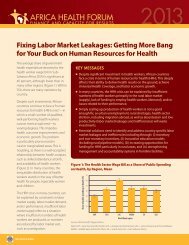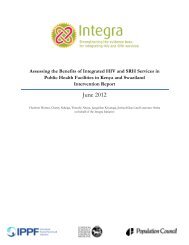ujh78
ujh78
ujh78
Create successful ePaper yourself
Turn your PDF publications into a flip-book with our unique Google optimized e-Paper software.
In sub-Saharan Africa the percentage of children living in houses without electricity was very<br />
high (see Map 5.2)—above 75% in the majority of countries. Nine of every 10 children lived in houses<br />
without electricity in Burkina Faso, Burundi, Chad, Liberia, Malawi, Niger, Rwanda, and Uganda. Only<br />
two countries, Ghana and Senegal, had rates below 50% (see Table 5.3).<br />
Sex and geographic disparities<br />
There was no sex disparities related to having electric power at home (see Figure 5.7). In every<br />
country, however, a higher percentage of rural children than urban children live in houses without<br />
electricity (see Figure 5.10). This discrepancy was greatest—about 75 percentage point—in Ethiopia and<br />
Zimbabwe. Liberia (a difference of 6 percentage points) had the smallest geographic disparity (see Table<br />
5.3).<br />
The role of the household head’s sex and age<br />
The sex of the household head mattered only in Senegal. The percentage of children living<br />
without electricity was 53% for children living with a male household head and 27% for their<br />
counterparts living with a female household head, a difference of 26 percentage points (see Figure 5.9 and<br />
Table 5.3).<br />
In Namibia and Uganda the percentage of children without electricity was much higher for<br />
individuals living with a household head age 50 or older than for children living with a younger<br />
household head (see Figure 5.10). In Namibia this difference reached 29 percentage points (58% and<br />
87%) (see Table 5.3). Zimbabwe exhibits the inverse pattern: 69% of children in households with heads<br />
younger than 50 years old lived in houses without electricity compared with 87% of children living with a<br />
younger household head—a difference of 19 percentage points.<br />
Variations during the last 13 years<br />
In most countries the percentage of children living in homes without electricity dropped between<br />
surveys—by about 10 percentage points in Ghana (2003: 59% and 2008: 48%), Lesotho (2004: 96% and<br />
2009: 86%), Mozambique (2003: 90% and 2011: 79%), and Senegal (2005: 58% and 2010-11: 48%) (see<br />
Table 5.2). In contrast, the percentage of children living in houses without electricity increased in<br />
Madagascar (2 percentage points more) and Nigeria (4 percentage points more) (see Figures 5.11 and<br />
5.12).<br />
89








